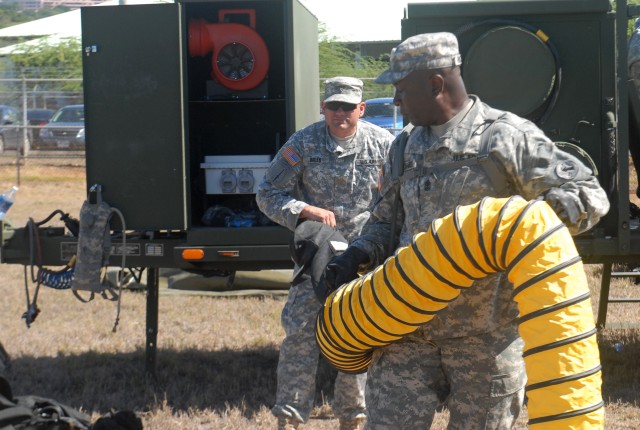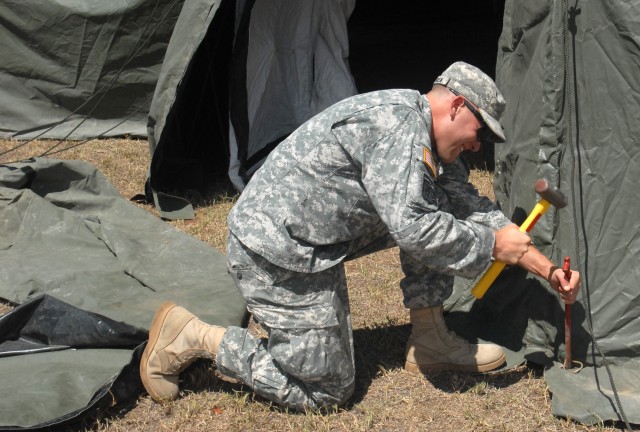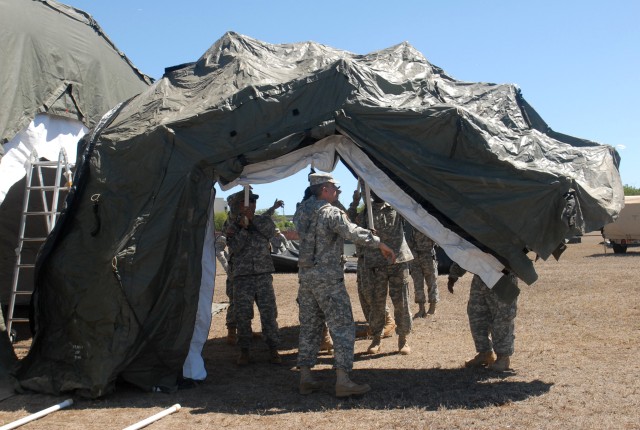FORT SHAFTER FLATS, Hawaii - Senior field grade officers, noncommissioned officers and junior enlisted Soldiers from the U.S. Army, Pacific Contingency Command Post worked side-by-side Sept. 7-24 at Fort Shafter Flats for Exercise Autumn Laulima, turning an empty field into a self-sustained operational command post.
Laulima is the Hawaiian word for teamwork - in this case, that team being the players who comprise the USARPAC CCP.
"What a fitting name for this exercise, especially since what we need this autumn is a lot of teamwork to get everyone trained up in this baseline phase exercise," said Lt. Col. Nathan K. Watanabe, chief of current operations, USARPAC CCP.
Watanabe oversees the running of the current operations integration cell which assembled tents and generators with the rest of the CCP during the exercise.
"Because we've had almost an 80 percent turnover in the past year, the CCP needed to build that muscle memory and this exercise re-established a baseline familiarity with our systems, to include computer systems and theater battle tactical command systems, as well as our power generation systems and our tent and vehicles systems."
Following immediately after the CCP's first load exercise, held Aug. 30-Sept. 2, Autumn Laulima is one of many steps on the new unit's climb towards becoming Fully Operational Capable. Once FOC, the CCP will be certified to deploy anywhere in Pacific Command's area of responsibility.
"The CCP's mission is to be ready to rapidly deploy to provide a command and control headquarters to the USARPAC commanding general in a humanitarian assistance/disaster relief scenario or small-scale contingency," said Watanabe.
"We also will provide a headquarters element for many of the theater security cooperation engagements for pacific command. Because of this mission we need to maintain familiarity and proficiency with our systems, and Autumn Laulima establishes that."
The CCP is unique to the U.S. Army. The Army-level command consists of 96 core personnel, with 73 military occupational specialties augmented by staff from the headquarters battalion, contracting, signal and intelligence elements within USARPAC to support mission operations.
Autumn Laulima provided the CCP team an opportunity to test every one of its operational elements.
"We are exercising everything we've got, from our vehicles to all our tents, to all our command and control systems, to all our personnel, so that we again have oriented and introduced all our systems to all our personnel, especially the 80 percent new personnel," said Watanabe.
While the CCP ran the exercise, assistance from other units was paramount to the success of the endeavor.
During the exercise, Spc. Richard Gitzschlag, USARPAC HHB power generation mechanic, taught teammembers operation and set up of generators and the air conditioning units. He also ensured there was a working power grid set up, made sure the generators ran well and was on hand to assist with repairs.
According to Watanabe, another important aspect of the exercise was the support received from field service representatives. The FSRs are civilian contracted subject-matter experts on the computerized systems used by the CCP, available throughout the exercise.
Other units assisting the exercise were the 500th Military Intelligence Brigade, 311th Signal Command, USARPAC Main Command Post and USARPAC headquarters support company and Headquarters and Headquarters Battalion.
"For a unit that doesn't take their systems out and play with them often, it's going great," said Bonnie Looke, digital system engineer.
"Everybody is talking, and the whole staff is out on the floor, fully engaged, which kind of surprised me, to see the unit this involved, so to see that was impressive."














Social Sharing